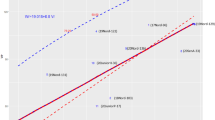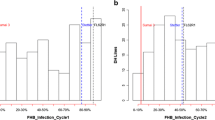Summary
Crosses were made among ten winter wheat genotypes representing different levels of resistance to Fusarium head blight to obtain F1 and F2 generations. Parents, F1 and F2 were inoculated with one strain of Fusarium culmorum. Data on incidence of head blight 21 days after first inoculation were analyzed. Broad-sense heritabilities averaged 0.39 and ranged from 0.05 to 0.89 in the individual F2 families. The joint-scaling test indicated that the inheritance of Fusarium head blight resistance was adequately described by the additive-dominance model, with additive gene action being the most important factor of resistance. With respect to the non-additive effects, dominance of resistance predominated over recessiveness. The number of segregating genes governing resistance in the studied populations was estimated to vary between one and six. It was demonstrated that resistance genes differed between parents and affected resistance differently.
Similar content being viewed by others
References
Bulmer M.G., 1985. The mathematical theory of quantitative genetics. Clarendon Press, Oxford. 254 pp.
GuJiaqing, 1983. A study on the genetics of resistance to wheat scab. Sci. Agric. Sinica 6: 61–64.
Mather K. & J.L.Jinks, 1982. Biometrical genetics. The study of continuous variation. 3rd edition. Chapman & Hall, London, New York. 396 pp.
Snijders C.H.A., 1990a. Diallel analysis of resistance to head blight caused by Fusarium culmorum in winter wheat. Euphytica 50: 1–9.
Snijders C.H.A., 1990b. Response to selection in F2 generations of winter wheat for resistance to head blight caused by Fusarium culmorum. Euphytica 50: 163–169.
Steel, R.G.D. & J.H. Torrie, 1981. Principles and procedures of statistics. A biometrical approach. International Edition. McGraw-Hill International Editions, 633 pp.
VanGinkel M. & A.L.Scharen, 1988. Host-pathogen relationships of wheat and Septoria tritici. Phytopathology 78: 762–766.
Wricke G. & W.E.Weber, 1986. Quantitative genetics and selection in plant breeding. De Gruyter, Berlin, New York. 406 pp.
Wright S., 1968. Genetic and biometric foundations. Evaluation and the genetics of populations. A treatise in three volumes. Volume I. Genetic and biometric foundations. The University of Chicago Press. Chicago and London. 469 pp.
Yu Y.J., 1982. Monosomic analysis for scab resistance and yield components in the wheat cultivar Soo-moo-3. Cereal Res. Commun. 10: 185–190.
ZhangLe-qing & PanXue-ping, 1982. A study on resistance to colonization of Gibberella zeae in wheat varieties. J. South China Agric. College 3: 21–29.
Zhou C.F., S.S.Xua, C.M.Qian, G.C.Yao & J.X.Shen, 1987. On the problem of breeding wheat for scab resistance. Sci. Agric. Sinica 20: 19–25.
Author information
Authors and Affiliations
Rights and permissions
About this article
Cite this article
Snijders, C. The inheritance of resistance to head blight caused by Fusarium culmorum in winter wheat. Euphytica 50, 11–18 (1990). https://doi.org/10.1007/BF00023155
Received:
Accepted:
Issue Date:
DOI: https://doi.org/10.1007/BF00023155




